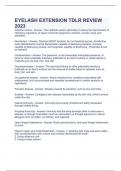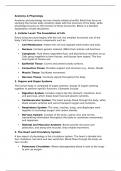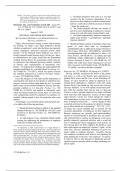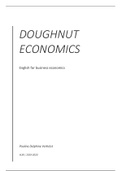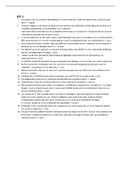Inhoud
Lecture 2.................................................................................................................................................2
Clark M, Hill J, Tilman D. (2018) The diet, health, and environment trilemma. Annual Review of
Environment and Resources 43: 109-134...........................................................................................2
Aiking H & de Boer J. (2018) The next protein transition. Trends in Food Science & Technology......4
Erisman JW et al. (2015) Nitrogen: too much of a vital source. Science Brief. Zeist: WWF
Netherlands........................................................................................................................................4
Lecture 3&4............................................................................................................................................6
Boesveldt et al. (2017). Anosmia – a clinical review...........................................................................6
Ares G. (2015). Methodological challenges in sensory characterization.............................................7
Issanchou S.(2015). Sensory & consumer studies with special populations: children and elderly.....7
Martin C, Visalli M, Lange C, Schlich P and Issanchou S. Creation of a food taste database using an
in-home “taste” profile method. Food Quality and Preference. 2014; 36(0): 70-80..........................7
Lecture 5.................................................................................................................................................8
Satia JA. Dietary acculturation and the nutrition transition: an overview Appl Physiol Nutr Metab.
2010; 35: 219-223...............................................................................................................................8
Nicolaou M, Doak CM, van Dam RM, Brug J, Stronks K and Seidell JC. Cultural and social influences
on food consumption in Dutch residents of Turkish and Moroccan origin: a qualitative study. J Nutr
Educ Behav. 2009; 41(4):232-241.......................................................................................................9
Lerman D, Maldonado R and Luna D. A theory-based measure of acculturation: The shortened
cultural life style inventory. Journal of Business Research. 2009; 62: 399-406..................................9
Lecture 7...............................................................................................................................................10
Larson N, Story M. A review of environmental influences on food choices. Ann Behav Med. 2009;
38(Suppl 1): S56-S73.........................................................................................................................10
Story M, Kaphingst KM, Robinson-O’Brien R and Glanz K. Creating healthy food and eating
environments: policy and environmental approaches. Annu Rev Public Health. 2008; 29:253-272.10
French J, Blair-Stevens C, McVey D and Merritt R. The marketing mix. In : Social Marketing and
public health. Theory and practice. Oxford University Press; 2010. p. 194-200...............................12
Steenhuis IHM, Poelman MP and Vermeer WM. Managing food portion size and its effect on
weight control. In: Managing and preventing obesity, Woodhead Publishing, Editor: T. Gill. 2015,
pp. 167-179......................................................................................................................................13
Cohen DA, Babey SH. Contextual influences on eating behaviors: heuristic processing and dietary
choices. Obes Rev. 2012; 13(9): 766-779..........................................................................................13
Lecture 8...............................................................................................................................................15
Velema, E.,Vyth, E.L., Hoekstra, T., Steenhuis, I.H.M. (2018). Nudging and social marketing
techniques encourage employees to make healthier food choices: a randomized controlled trial in
, 30 worksite cafeterias in The Netherlands. The American Journal of Clinical Nutrition, 107(2), 236–
246....................................................................................................................................................15
Cadario, R., Chandon, P. (2020). Which Healthy Eating Nudges Work Best? A Meta-Analysis of Field
Experiments. Marketing Science.......................................................................................................16
Velema, E., Vyth, E.L., Steenhuis, I.H.M. 'I've worked so hard, I deserve a snack in the worksite
cafeteria': A focus group study. Appetite 2019.................................................................................17
Geaney et al (2013). The effectiveness of workplace dietary modification interventions: A
systematic review. Preventive Medicine...........................................................................................17
Lecture 9...............................................................................................................................................18
Latzer, Y., Hochdorf, Z., Bachar, E., & Canetti, L. (2002). Attachment style and family functioning as
discriminating factors in eating disorders. Contemporary Family Therapy, 24(4), 581-599. Part of
learning object #1.............................................................................................................................18
Langdon-Daly, J., & Serpell, L. (2017). Protective factors against disordered eating in family
systems: a systematic review of research. Journal of eating disorders, 5(1), 12. Part of learning
object #2...........................................................................................................................................18
Eilander, M. M., de Wit, M., Rotteveel, J., Aanstoot, H. J., Bakker ‐van Waarde, W. M., Houdijk, E.
C., ... & Snoek, F. J. (2017). Disturbed eating behaviors in adolescents with type 1 diabetes. How to
screen for yellow flags in clinical practice?. Pediatric diabetes, 18(5), 376-383. Part of learning
object #3...........................................................................................................................................18
Lecture 2
Clark M, Hill J, Tilman D. (2018) The diet, health, and environment
trilemma. Annual Review of Environment and Resources 43: 109-
134.
Overweight if BMI > 25 and obesity if BMI > 30.
Diet, health and environment trilemma: the links between diets, human health and environmental
degradation. These problems are on a trajectory to become progressively more severe during the
coming decades, especially in developing nations, because dietary shifts toward less healthy and less
sustainable diets are tightly associated with increased affluence and urbanization.
The most rapid increases are in:
- Caloric demand/ sugar intake
- Animal-based food (meat, fish, dairy, eggs)
- Overweight and obesity
- Nitrogen fertilizer application (increase of 860% since 1961)
- Fresh fruit and vegetables (all regions except Western Asia)
- Diabetes and other diet related diseases
- Agricultural land use and GHG emissions (Greenhouse gas)
The environment and health impacts of different types of foods
GHG emissions:
, - Dairy, eggs, pork, poultry, and low-impact fish production systems have GHG emissions
approximately 100% to 2,500% higher than those of plant-based foods per kilocalorie of food
produced.
- Production of high-impact fish and ruminant meats (beef, sheep, goat) has GHG emissions
approximately 2,000% to 10,000% larger than those of plant-based foods per kilocalorie of
food produced.
Land:
- Plant-based foods have the lowest land use requirements per kilocalorie of food produced.
- Dairy and eggs require several times more land than plant-based foods.
- Pork and poultry require approximately 100% to 400% more land than dairy and eggs.
- Ruminant meats require approximately 2,000% to 10,000% more land (depending on the
extent of grazing) than plant-based foods.
Nutrient pollution per kilocalorie of food (=measured as the amount of nutrients that leave a farming
system and enter the surrounding environment):
- Production of plant-based foods results in the smallest amount of nutrient pollution per
kilocalorie of food produced.
- Production of a kilocalorie of fresh fruits and vegetables results in approximately twice the
amount of nutrient pollution as other plant-based foods, which is largely because the caloric
contents of vegetables and fruits are low.
FCR= feed conversation ratio (the amount of feed protein is required to produce a gram of edible
animal protein):
- Eggs 2.6, diary 3.9, poultry 4.9, pork 5.7, goat meat 14.4 and beef 19.3.
Different diets:
- Mediterranean diets: containing large amount of fruits, vegetables, whole grains, legumes,
moderate amounts of seafood, and small amounts of other meats and as using olive oil as
the primary oil.
- Vegetarian diets: contain dairy and eggs, but very limited amounts of other meats.
- Pescetarian diets: include fish, dairy, and eggs, but very limited amounts of other meats.
- Vegan diets: contain very limited amounts of dairy, eggs, or meat.
Improve agriculture sustainability by:
- Get a more plant-based diet increasing access to healthier foods, taxation of less healthy
or sustainable food (such as sugared beverages), food labelling to shift habits, integrating
sustainability into government recommended dietary guidelines.
- Closing yield gaps
- Reducing food waste (lower income and developing nations waste a larger proportion of
food during production and transport, largely because of lack of infrastructure and poor
storage facilities. In contrast, higher-income nations tend to waste more food at retail stores
and households, partially because of aesthetic quality standards)
- Increasing efficiently of fertilizer application
- Land use planning


